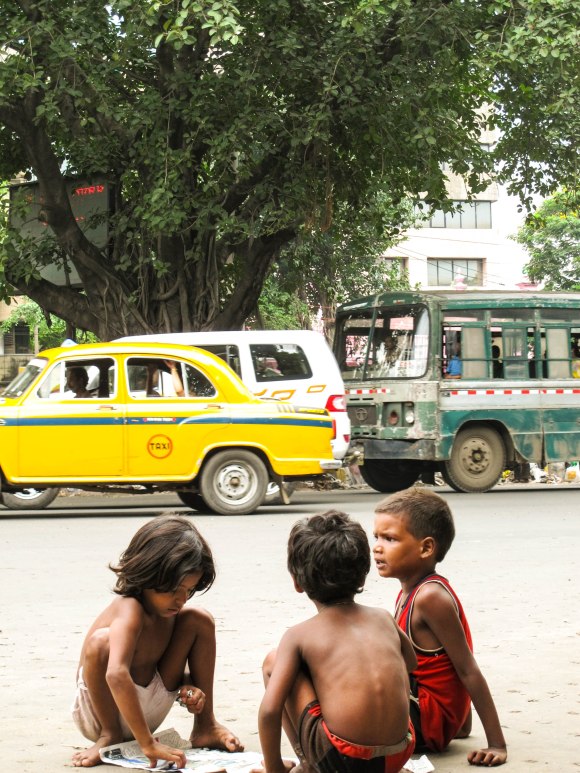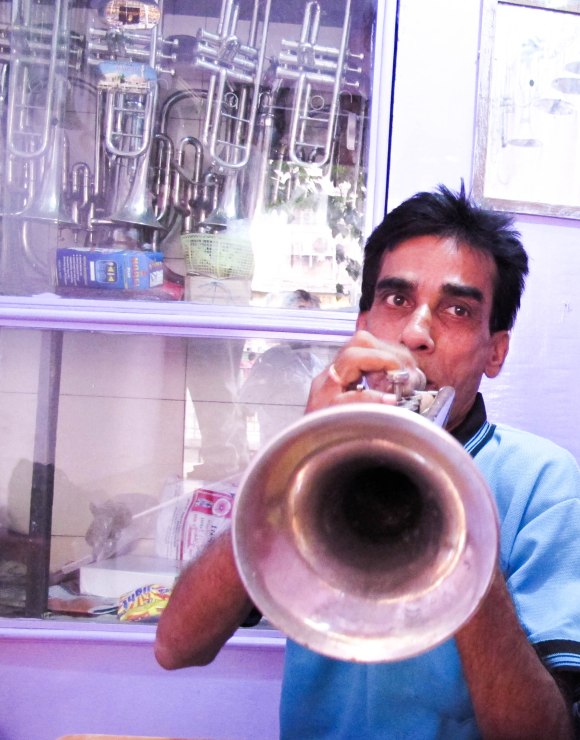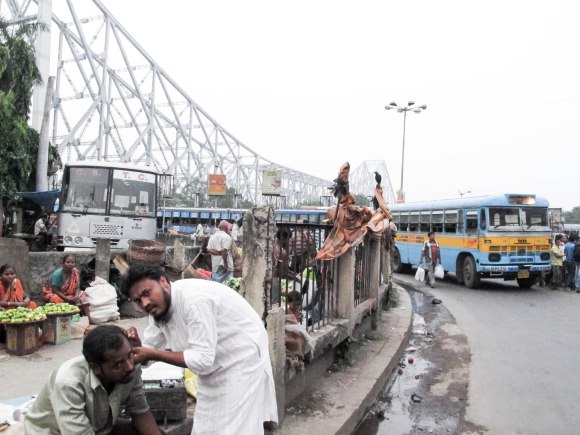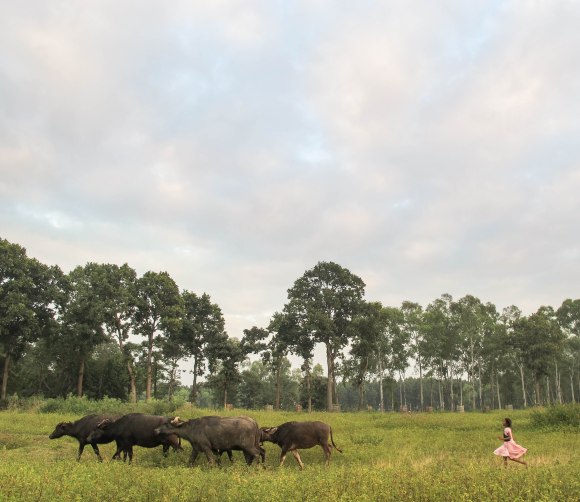
You see, but you do not observe
Sherlock Holmes in A Scandal in Bohemia
About a month or so into this fellowship, we had a friend, another fellow named Andrew, visit Calcutta from his placement in Ranchi[1], a town of urban sprawl that’s stuck in a sort of identity crisis between rural and urban. Hallie and I wanted to take Andrew around to some of the major sites of the city to give him a feel for Calcutta (being the good Calcuttan hosts we are). Our first stop could be the site for the image that’s plastered on postcards for Calcutta, the Howrah Bridge, then the technicolor flower market underneath it, followed by a ride on a ferry across the Hughli River from any of the docks (or “ghats”).
It played out messier in reality. We walked desperately in the blazing heat along the main road; we couldn’t find a ghat with a ferry, we were disoriented, and I wasn’t sure whether the dainty handkerchief I carried was taking sweat off my skin or depositing more on it. To make matters worse, the map we used, from a book called “10 Walks in Calcutta,” looked like it was made in Microsoft Paint by a six-year-old. “May not be to scale” was an understatement. “May not use the cardinal directions” would have been more accurate.
Our first attempt was into one of the most famous central riverside ghats: Babu Ghat, known for its enormous Roman style pillars. To navigate there, we had to cut through a brickmaking factory ten feet from the entrance, the orange dust coating the air. Once we got past the pillars, though, I realized we wouldn’t find any ferries here, just dozens of men bathing in the murky waters. We’d have to keep walking. It was then that Andrew asked me if I’d seen it: a mother cradled a crying newborn, not more than ten days old, just feet from the cloud of dust that engulfed the entrance to Babu Ghat. There were little moments like these as we walked with Andrew, his perception of Calcutta reminding me what I perceived when I first came here, but no longer did: the poverty, the stench, the overcrowding.
We continued on, my confidence in my ability to provide any cultural experiences for our guest spiraling downward. The next ghat looked promising: a big blue sign and what looked like wooden planks for a dock. We crossed the train tracks onto the riverside. I looked to my left: there were ten to fifteen shacks along littered riverside.
I gradually panned over to look for any incoming ferries we could grab, but something caught my eye on my right-hand side. There was a strange object lying on the beach. I tried to sharpen my focus: I noticed some netting, then a strangely familiar outline underneath it, and then some vaguely reddish areas. We realized it at the same time: it was the remnants of a human body. It lied there, swollen and burned by the sun, appendages missing and disfigured, a stone’s throw from a small neighborhood of poor households. No one cared, and no one was paid enough to clean it up. Andrew broke the stunned silence with a suggestion to get out of there, with which we quickly agreed. We found a ferry, eventually, and crossed across the Hughli, the peace of the river punctuated by a brother-sister pair of toddlers dancing in ridiculous makeup and garb, their mother playing a drum loudly. Most of the passengers on the boat didn’t give them a second look.
On the boat, I reflected what we’d seen that day. Was I scared with the death and decay that sometimes nakedly showed itself here? Was I mentally overwhelmed with some of the sites that I saw on a daily basis? I searched myself for any feelings of fear or shock, and came up empty. That, I realized was what scared me the most, not the decomposing body, or the newborn engulfed in brick smoke, or the near-lethal smells and intense poverty surrounding Howrah station, but the fact that I was desensitized to all of these things.

I think it would be fair to say my mental frame has shifted in the three months I’ve been here now. In Cutting for Stone, Abraham Verghese describes an Ethiopian immigrant’s experience coming to America in a beautiful passage:
Superorganism. A biologist coined that word for our great African ant colonies, claiming that consciousness and intelligence resided not in the individual ant but in the collective ant mind. The trail of red taillights stretching to the horizon as day broke around us made me think of that term. Order and purpose must reside somewhere other than within each vehicle. That morning I heard the hum, the respiration of the superorganism. It’s a sound the new immigrant hears but not for long. By the time I learned to say “6-inch Number 7 on rye with Swiss hold the lettuce,” the sound, too, was gone. It became part of what the mind would label silence. You were subsumed into the superorganism.
Whatever the equivalent of a “6-inch Number 7 on rye with Swiss hold the lettuce” is in Calcutta, I’ve surely figured it out by now (probably the “doh onda, doh chicken”- double egg, double chicken- to the Kati roll man). I can navigate the city by public transit, I know both the best street-food and fine dining restaurants, and I’ve understood how not only how to prevent cutting in lines but also how to cut myself. Familiarity, though, has rendered certain things background noise.

Three months in, I’m desensitized to certain scenes that would have once surprised me when I first came here. I’m desensitized to the men like ants, carrying packages full of goods heavier than they are on their heads, filing by the hundreds of thousands across Howrah Bridge. Desensitized to the man who lies outside Howrah railway station as my bus passes daily, his skin indistinguishable from his clothes in shade of brown. Desensitized to the children, their eyes big and their stomachs small, who tug forcefully at my arm pleading for change yelling “Dada! Dada!” at the traffic stops. I’ve become an expert at avoiding eye contact and giving money in such situations, but sometimes I break. Desensitized to riding to work in speeding iron buses that feel like they’re taped together (one a week ago that caused a three-bus collision and nearly flattened an elderly passenger as he tried to grab onto it as it raced past his stop).
I’m desensitized to the sadhu, an ascetic man of orange robe, patientely waiting in line at the Baskin Robbins on Park Street (apparently, not even people who don’t believe in very idea of the material world can resist 31 delectable flavors). Desensitized to the men loudly hawking loogies from the deepest depths of their esophagus early in the morning, sending phlegm bulleting to the roadside. Desensitized to the “crush or be crushed” mentality of the metro. Desensitized to the insane traffic, no longer insane but comprehensible, a mess through which I can weave with little issue if I have my wits about me.
Now I pop in my iPod on my daily commute and just see these things, no longer observing them, no longer surprised or even aware.

The taxi stand at Howrah station

Boys playing soccer at Rabindra Sarobar park

One of a series of horns stores near Central Station. Kolkata was once a hotbed of jazz, but no longer: “Searching for Kolkata’s Lost Jazz Scene”

The ear-cleansing man under Howrah bridge staring unhappily at me capturing the tricks of his trade.

This was, in some sense, an inevitable phenomenon. It’s a universal rule to how we interact with the world: we’re creatures of equilibrium, creatures of adaptability. Given enough time, new information is eventually synthesized and processed unconsciously by the mind, even if its as much information as Calcutta throws at a person on a second to second basis.
There’s a story about the eminent South African psychologist Joseph Wolpe. Faced with a patient, a teenage girl who was deathly afraid of cars, he pondered about what to do for her debilitating condition. Basing his intervention on Pavlov’s famous conditioning experiments on dogs, Wolpe took the girl into a car and drove her around with the doors locked to decondition her. It was extreme and probably unethical by today’s research standards, but her initial panic lessened after a while and (with the aid of Wolpe’s relaxation techniques) her fear of cars went away. Flooding, they called it: when the very object that provokes a negative stimulus is exposed to the patient in an intense way, “at its worst.” The phobia drops away as the person makes new associations, like ease instead of fear.[2],[3]
Living in such an environment, there’s a steady diet of either flooding and systematic desensitization, a city-wide mode of therapy designed to make you numb to certain things: dirt, squalor, and cognitive dissonance among them.


Shattering a Man’s Sense of Natural Justice
I’m OK, though, with getting used to most of these things. It makes my life easier when, for example, I’m not hunting for half an hour searching for the Esplanade metro station entrance as if it’s on Platform 9¾. What I’m not OK with is degradation of other things along with it: my sense of right and wrong, of justice, of ethics.
It reminded me of an article on the effect of Stalin and Hitler on Eastern Europe, in which the author quoted Czeslaw Milosz, the Polish poet:
Once, in an attempt to explain the history of his country to outsiders, the Polish poet Czesław Miłosz described the impact of war, occupation, and the Holocaust on ordinary morality. Mass violence, he explained, could shatter a man’s sense of natural justice. In normal times, had he stumbled upon a corpse on the street, he would have called the police. A crowd would have gathered, and much talk and comment would have ensued. Now he knows he must avoid the dark body lying in the gutter, and refrain from asking unnecessary questions….
Murder became ordinary during wartime, wrote Miłosz, and was even regarded as legitimate if it was carried out on behalf of the resistance. In the name of patriotism, young boys from law-abiding, middle-class families became hardened criminals, thugs for whom “the killing of a man presents no great moral problem.” Theft became ordinary too, as did falsehood and fabrication. People learned to sleep through sounds that would once have roused the whole neighborhood: the rattle of machine-gun fire, the cries of men in agony, the cursing of the policeman dragging the neighbors away.
For all of these reasons, Miłosz explained, “the man of the East cannot take Americans [or other Westerners] seriously.” Because they hadn’t undergone such experiences, they couldn’t seem to fathom what they meant, and couldn’t seem to imagine how they had happened either. “Their resultant lack of imagination,” he concluded, “is appalling.”
It’s not a comparable situation at all of course; I’m not really capable of evaluating levels of mass human suffering like that. Still, I was somehow drawn to the idea that in some historical situations, things that would be considered deeply unethical under normal circumstances become regular, even commonplace. Inequity, disgusting levels of inequity, when there for long enough become part of the background. I’m worried that I, too, am having my sense of justice warped, putting things into the background that shouldn’t be. I’m worried that I’m sleeping through sounds that would have once roused me.
When I was young, we made biannual family trips to Hyderabad where my grandparents lived and my mother grew up. I can viscerally remember the shock at such stark differences to the United States: blue tents pitched next to a Tommy Hilfiger outlet, families (plural) living under them. It wasn’t right, I remember thinking, that kind of disparity. They were as human as I was, but the difference in the opportunities I had and they did was huge (and not unlike some of the inequities I saw when I went back to parts of my hometown of Cleveland). It became a driving force for me, and it was events like that one that have led me to be in Cal today.
There was something else about those trips that I remember though: conversations with people (who were and are empathetic and generous by any measure), my friends and family there, speaking about the situation as if it were set in stone and just a fact of life. They’d lived with these things for their entire life, and I hadn’t, and my naïve and idealistic viewpoint was just an “American” point of view. I’d come around, they seemed to imply with their answers to my pointed questions about such despair and inequity, I’d realize that this was the way the world worked. My moral dilemma was not a dilemma for them at all.
At what point does something intolerable become tolerable? And am I getting to that point with the simple act of living, day in and day out, with some of these circumstances around me?
I’m aware that, like heavy eyelids pushing sleep, desensitization is a seductive and easy prospect. And I’m worried that along with this sense of resignation will come a degradation in my sense of justice, and attached to that my sense of meaning and the things that drive me. The only remedy I’ve found is paying constant attention to my surroundings, not allowing the unconscious mind to swallow the conscious one, and reflection on the disparity between what’s around me and what it could be. Luckily, my work with Calcutta Kids (as thoughtful and meaningful of an organization as they come) helps.[4]

___________________________________________________________________________
[1] In the Lonely Planet guide to India, as Andrew describes in his blog post, Ranchi’s description has the following epigram “For travelers there’s not a lot of interest in the city and it’s not really on the way to anywhere.” Ha- ha good one, Lonely Planet, but I have to disagree with you here. I visited Andrew and Ashutosh there, where we frolicked in the “touch-me-not plants” by their NGO’s headquarters, saw a wheezy, old Bengal tiger and went for a Venetian paddle-boat ride in the zoo, and went through some dangerous villages (read: Maoist terrorists) to get to Hundru Falls, a gorgeous waterfall. Here’s photographic evidence:



Hundru Falls
[2] Interestingly enough, this is exactly what horse trainers do to horses. It’s called “sacking out.” Horses are naturally afraid of unknown stimuli, but the horse trainer has to teach the horse to be unafraid of, say a rope, cloth, or a human leg. Eventually through traumatic ‘flooding’ the horse is taught not to be afraid, and to trust the trainer. I swear to god I don’t spend that much time on “ultimatehorsesite.com”…
[3] Legend has it that Dean Martin (“That’s Amore” and Rat Packer) did something similar. Dean Martin had a terrible fear of small spaces, which made it difficult to go up by elevator to many of the record company’s headquarters on the top floors of Manhattan buildings. Dino usually had to climb the stairs. Trying to overcome this fear, he decided to put himself into an elevator and ride and up and down in a NYC building until his claustrophobia was gone.
